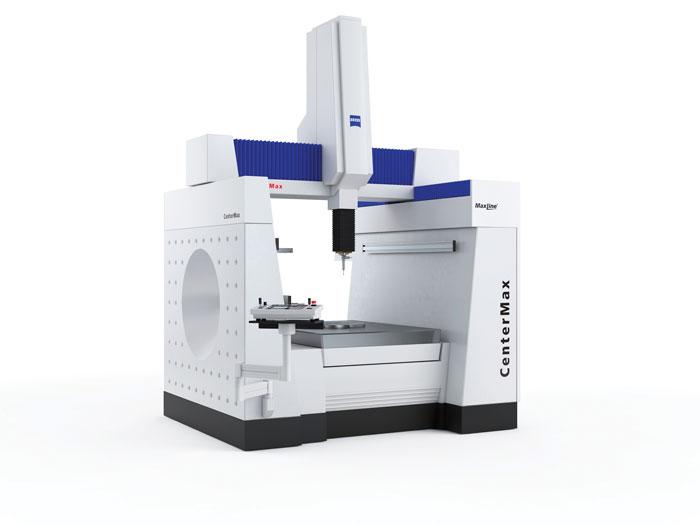- FMA
- The Fabricator
- FABTECH
- Canadian Metalworking
Shop Floor Measurements
CMMs designed for shop floor use are replacing traditional gauges in many applications
- September 21, 2015
- Article
- Measurement

CenterMax CMMs from Zeiss have a polymer concrete base with Invar® struts to help keep the machine thermally stable. Image courtesy of Elliott Matsuura Canada.
Expensive, one-use gauging is becoming a thing of the past. Flexible measurement is now the domain of coordinate measuring machines (CMMs) specifically designed for shop use. CIM—Canadian Industrial Machinery asked Elliott Matsuura Canada Metrology Product Manager Rob Johnston for his thoughts. Here is what he had to say.
CIM: Is it becoming more common for CMMs to be part of the shop floor rather than in a dedicated QA room?
Johnston: Yes. Shop floor CMMs are not necessarily replacing machines that traditionally are found in a QA room, but they are more common as a gauge replacement tool. There can be significant upfront and legacy costs associated with gauging, and these costs can be reduced with a shop floor CMM.
CIM: What determines where measuring takes place?
Johnston: The two variables are environment and the type of inspection. The idea of having inspection closer to manufacturing has been a goal of this sector for decades. However, the environment and available shop floor real estate often play major roles. A shop floor machine does not mean “outdoor” machine; temperature, humidity, vibration, and other factors influence the ability of the inspection equipment to perform.
The second variable in determining where measurement takes place is the role of the machine. CMMs play an important role in process analysis, reverse engineering, and product development. These examples are bettersuited to a controlled environment.
CIM: What is the main benefit of moving the measurement process closer to the production process?
Johnston: Reaction time. When production people are immediately alerted to a process that is going out of control or a nonconforming bad part, the quicker they can fix the problem.
A second benefit is having inspection data related to the manufacturing data. Having your parts measured at the temperature when manufactured, or close to it, obviously provides better process monitoring. When you remove a part from the process and it cools or acclimatizes to the QA lab, you can change the part, sometimes significantly.
CIM: When should a shop consider a shop floor CMM?
Johnston: When you want to reduce overall inspection time and capture process data closer to the time of manufacture. A shop floor CMM reduces your overall inspection time simply by reducing the workflow of the part. Many companies still move a tray of parts from the floor to a QA lab and simply don’t measure the time that parts are waiting to be inspected, either because of transit, acclimatization, or backlog.
CIM: Can a CMM today be just another part of the production line like the machine tool and material handling system?
Johnston: Yes, through automation integration. CMMs can be an active part of a production line, receiving parts from a robot or transfer line, measuring the part, and even providing corrections to the machine tool.
CIM: What changes in CMM technology are making the shop floor a viable location for measuring?
Johnston: There are three changes. The first is thermal stability. The machine needs to be designed in a way that allows it to be accurate and repeatable as the temperature changes. Machine construction requires materials to be used that are minimally influenced by temperature. For example, the GageMax and CenterMax CMMs from Zeiss have a polymer concrete base with Invar® struts. The new DuraMax has a stainless steel shell to further reduce the influences of temperature.
The second change is to protect from vibration. Either the CMM has the necessary vibration dampening system or you have to pour a foundation that isolates the machine from the ambient vibrations. Shop floor vibrations come from many different sources, including the overhead crane, local CNC machines, forklifts, automation tables, or even nearby train tracks.
The third necessary feature is to protect the CMM from the environment. Shop floor CMMs are designed to minimize the presence of oil, mist, and smoke, but the technician should still clean and use common maintenance procedures to maximize the performance and life of the machine. Covers and bellows protect against oil, coolant, and debris, but the cleanliness of the part also needs to be considered. Measuring a part with coolant or chips is not desired, so it usually means having to add a trip to the wash station before putting it on the CMM.
subscribe now


Keep up to date with the latest news, events, and technology for all things metal from our pair of monthly magazines written specifically for Canadian manufacturers!
Start Your Free Subscription- Trending Articles
- Industry Events
MME Winnipeg
- April 30, 2024
- Winnipeg, ON Canada
CTMA Economic Uncertainty: Helping You Navigate Windsor Seminar
- April 30, 2024
- Windsor, ON Canada
CTMA Economic Uncertainty: Helping You Navigate Kitchener Seminar
- May 2, 2024
- Kitchener, ON Canada
Automate 2024
- May 6 - 9, 2024
- Chicago, IL
ANCA Open House
- May 7 - 8, 2024
- Wixom, MI














